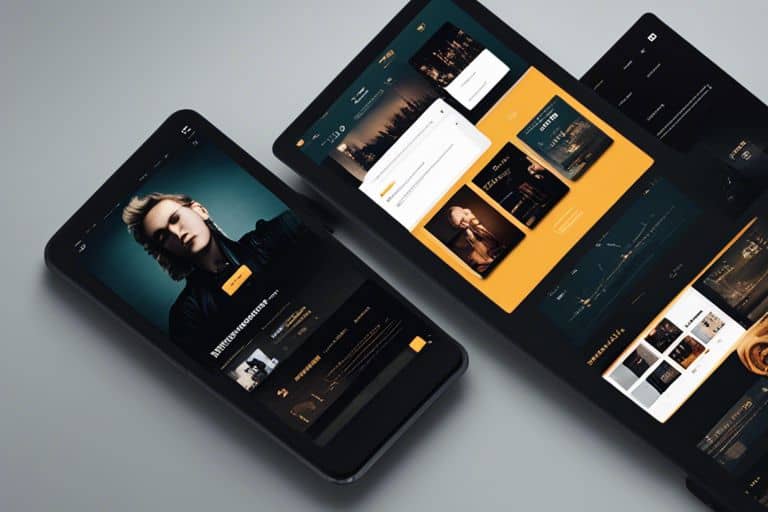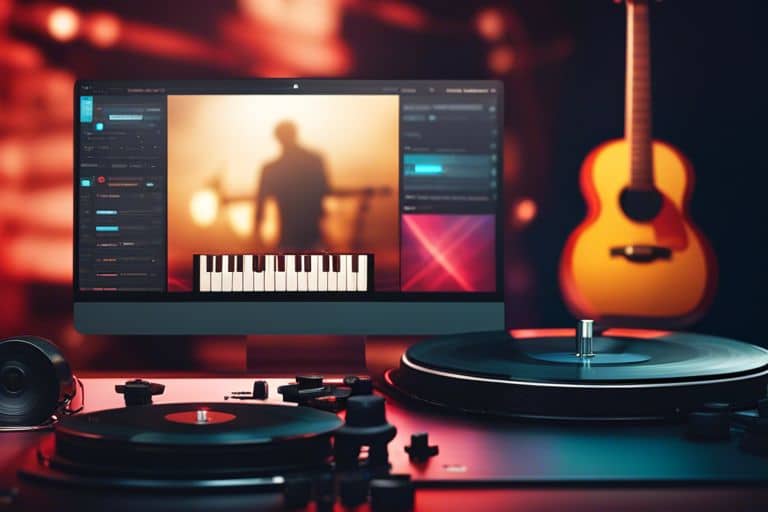
In this comprehensive guide, we will walk you through the process of creating a professional website for musicians. Designing your website can seem like a daunting task, but with our step-by-step instructions, you’ll be able to showcase your music in no time. Whether you’re a solo artist, band, or music prodGuide to Creating a Rockin’ Music Website: Everything You Need to Know Designing Your Website Strategyucer, having an online presence is crucial in today’s digital age. From choosing the right website builder to customizing your design, we’ve got you covered. For a more in-depth guide on creating a website specifically tailored for musicians, check out Create a Website for Music That Rocks: Complete Guide.
Planning Your Web Design Project
For musicians looking to create a professional online presence, designing a website is a crucial step. Proper planning is vital to ensure that your web design project is successful and meets your needs effectively. In this chapter, we will probe into the important aspects of planning your web design project.
Setting Clear Goals and Objectives
Designing a website without clear goals and objectives is like begining on a journey without a map. Before you start designing your website, take the time to define what you want to achieve with it. Do you want to showcase your music and videos? Sell merchandise and tickets to your shows? Build a fan community? Setting clear goals will help you shape the design and functionality of your website to meet your specific needs.
Once you have defined your goals, break them down into measurable objectives. For example, if your goal is to increase online ticket sales, your objective could be to increase ticket sales by 20% within the next six months. Setting measurable objectives will help you track your progress and make adjustments to your website as needed.
Evaluating Time and Resource Commitment
The success of your web design project also depends on the time and resources you are willing to invest in it. Evaluate how much time you can dedicate to designing and maintaining your website. Consider whether you have the skills to design the website yourself or if you need to hire a professional web designer. Assess your budget for hosting, domain registration, and any additional tools or plugins you may need for your website.
The time and resources you commit to your web design project will directly impact the quality and functionality of your website. Be realistic about what you can achieve with the time and resources available to you, and be prepared to adjust your project scope accordingly.
With a clear understanding of your goals and objectives, as well as a realistic evaluation of your time and resource commitment, you will be well-equipped to start planning and designing your musician website. Stay tuned for the next chapter, where we will discuss the crucial step of defining your brand and visual identity for your website.

Types of Web Design Platforms for Musicians
Obviously, as a musician looking to take your online presence to the next level, choosing the right web design platform is crucial. There are various options available, each with its own set of features and benefits. Understanding the different types of web design platforms can help you make an informed decision that best suits your needs.
- Overview of Popular Web Builders
- Pros and Cons of Each Platform
Overview of Popular Web Builders
For musicians stepping into the world of web design, popular web builders offer a user-friendly interface and drag-and-drop functionality. These platforms, such as Wix and Squarespace, provide pre-designed templates and customization options to help you create a professional-looking website without the need for coding skills. With features like built-in SEO tools and e-commerce capabilities, you can easily showcase your music, sell merchandise, and connect with your fans.
After selecting a web builder, you can choose a template that aligns with your music style and brand aesthetic. Customizing colors, fonts, images, and content is straightforward, allowing you to personalize your website and make it reflect your unique identity as a musician. Whether you’re a solo artist, band, or music producer, these web builders offer flexibility and creative freedom to design a website that resonates with your audience.
Pros and Cons of Each Platform
The following table outlines the pros and cons of popular web design platforms:
| Pros | Cons |
|---|---|
| Easy to use | Limitations on customization |
| Wide range of templates | Subscription fees |
| Drag-and-drop functionality | Dependency on platform for updates |
| SEO tools | Limited scalability |
| E-commerce integration | Less control over backend |
The pros and cons of each web design platform play a significant role in determining the suitability for your music website. While ease of use and pre-designed templates can help you quickly set up a professional-looking site, limitations on customization and subscription fees are aspects to consider when making your decision. It’s imperative to weigh these factors against your specific needs and goals as a musician to choose the platform that aligns best with your vision.
Step-by-Step DIY Web Design Process
Once again, we will guide you through the step-by-step process of designing your own website as a musician. By following these simple steps, you can create a professional and engaging online presence to showcase your music and connect with your fans.
| Step 1: Choose the Right Platform | Step 2: Design Your Website |
| Research different website builders and select the one that fits your needs as a musician. | Customize the template with your brand colors, logo, and imagery to create a unique look. |
| Step 3: Add Content | Step 4: Optimize for Mobile |
| Upload your music, videos, photos, and bio to give visitors a comprehensive view of your work. | Ensure your website is responsive and looks great on all devices, especially mobile phones. |
Choosing the Right Template and Customization Tips
On your DIY web design journey, selecting the right template is crucial. Look for templates that are responsive, easy to navigate, and visually appealing. Once you’ve chosen a template, customize it to reflect your music brand. Add high-quality images, engaging content, and a color scheme that matches your style.
- Experiment with different fonts and layouts to make your website visually interesting.
This will help create a memorable experience for your visitors and keep them engaged with your music.
Implementing Music-Specific Features and Functions
Features such as a music player, event calendar, and mailing list signup form can enhance your website and provide value to your fans. By integrating these music-specific functions, you can create a dynamic and interactive platform that showcases your talent and keeps your audience informed.
For instance, you can embed a music player on your homepage so that visitors can listen to your latest tracks without navigating away from the site. This feature can improve user experience and encourage visitors to explore more of your music.
Design Factors That Make a Difference
Keep in mind that the design of your website plays a crucial role in engaging visitors and keeping them interested in your music. Here are some key factors to consider:
- Consistent branding elements such as colors, fonts, and imagery
- Clean and organized layout for easy navigation
- Mobile responsiveness for on-the-go fans
- Interactive features like music players or video backgrounds
- Fast loading times for a seamless user experience
Though the design of your website may seem like a small detail, it can make a big impact on how fans perceive your music and brand. Paying attention to these design factors can set you apart from other musicians online.
User Experience and Navigation Tips
Any successful musician website should prioritize user experience and easy navigation to ensure visitors find what they’re looking for quickly. Here are some tips to enhance user experience:
- Include a clear and intuitive menu structure
- Use descriptive labels for menu items and pages
- Ensure important information is easily accessible
After implementing these user experience and navigation tips, you’ll notice visitors spending more time on your website and engaging with your music in a more meaningful way.
Visual Branding and Aesthetic Considerations
Any musician looking to build a strong online presence must pay attention to visual branding and aesthetic considerations. Your website should reflect your unique style and music genre to leave a lasting impression on visitors.
Navigation plays a crucial role in guiding visitors through your website and helping them discover more about your music. Incorporating intuitive navigation menus and clear call-to-action buttons can improve the overall user experience and keep visitors engaged.
Maximizing Your Website’s Potential
Now that you’ve created a visually engaging and user-friendly website for your music, it’s time to maximize its potential. By utilizing various strategies and tools, you can ensure that your website reaches a wider audience and generates more traffic and engagement.
SEO Tips for Musicians
Your website’s visibility on search engines is crucial for attracting new fans and listeners. To improve your SEO, make sure to optimize your website with relevant keywords related to your music genre, location, and band name. Additionally, regularly update your website with fresh content like blog posts, tour dates, and new music releases to keep your audience engaged and improve your search engine rankings.
- Include meta tags and descriptions for each page of your website
- Utilize alt text for images to improve accessibility and SEO
- Create a sitemap to help search engines navigate your site easily
Any effort you put into optimizing your website for search engines will help increase your online presence and attract more visitors who are interested in your music.
Integrating Social Media and Streaming Platforms
The integration of social media and streaming platforms into your website is necessary for connecting with your audience and promoting your music. By including social media widgets, share buttons, and embedded music players on your site, you can encourage visitors to interact with your content and easily share it with their networks.
For instance, you can embed a Spotify player on your website to showcase your latest releases and encourage visitors to stream your music directly from your site. By linking your social media accounts to your website, you can also cross-promote your content and grow your online following across different platforms.
Maintenance and Updating Your Website
After you have successfully designed and launched your musician website, your work is not done. Regular maintenance and updating are crucial to ensure that your website remains relevant, functional, and engaging for your audience.
Routine Checkups and Content Refresh
The key to a successful musician website is keeping it fresh and up-to-date. Regularly schedule routine checkups to ensure that all links are working, images are loading properly, and contact forms are functioning as they should. Additionally, take the time to refresh your content, such as updating your bio, adding new music or videos, or sharing upcoming tour dates. Keeping your website current shows your audience that you are active and engaged.
By updating your content regularly, you not only provide value to your audience but also improve your search engine optimization (SEO) ranking. Search engines favor websites that are updated frequently with relevant content, which can help drive more traffic to your site and increase your online visibility.
Staying Current with Web Design Trends
Staying current with web design trends is vital to ensure that your musician website remains visually appealing and user-friendly. Keep an eye on the latest design trends, such as color schemes, typography, and layouts, and consider incorporating them into your website to give it a fresh look and feel. Responsive design, for example, is a trend that ensures your website looks great on all devices, from desktops to smartphones.
Staying informed about web design trends can also help you stay ahead of the competition and stand out in a crowded online space. By incorporating modern design elements and techniques into your website, you can create a memorable user experience that keeps visitors coming back for more.
Conclusion
Summing up, this step-by-step guide provides musicians with the vital tools and knowledge needed to design their own professional and engaging website. By following the outlined steps, musicians can create a visually appealing and user-friendly website that showcases their music and brand effectively. Embracing DIY web design can help musicians save money, have creative control, and stand out in the crowded online music landscape. With dedication and attention to detail, any musician can design a stunning website that captivates fans and promotes their music career.
Continue reading
Purely you



Leave a Reply